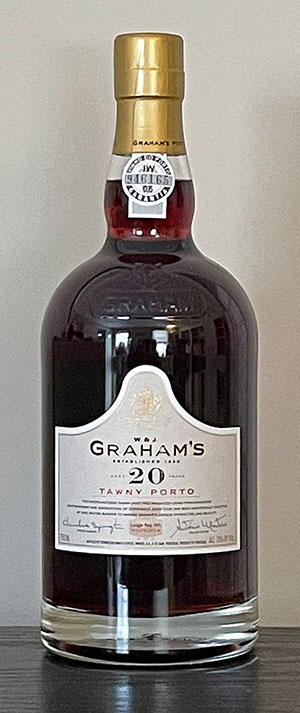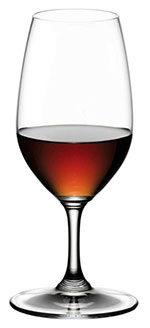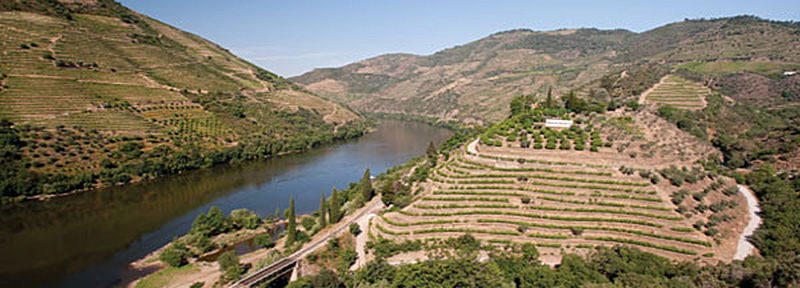 True Ports hail from the Douro valley in Northern Portugal, and have done so for over three hundred years. The region’s predominant soil is schist, composed of various medium-grained to coarse-grained metamorphic rocks with laminated, often flaky parallel layers of micaceous minerals. The low annual rainfall makes this probably one of the driest regions of the world where grapes are grown without irrigation. This terroir results in very low-yielding vineyards, with vines bearing only a very few small bunches of full-flavored grapes whose thick skins protect them from dehydration.
True Ports hail from the Douro valley in Northern Portugal, and have done so for over three hundred years. The region’s predominant soil is schist, composed of various medium-grained to coarse-grained metamorphic rocks with laminated, often flaky parallel layers of micaceous minerals. The low annual rainfall makes this probably one of the driest regions of the world where grapes are grown without irrigation. This terroir results in very low-yielding vineyards, with vines bearing only a very few small bunches of full-flavored grapes whose thick skins protect them from dehydration.
To make Port, a neutral grape alcohol is added to the wine partway through fermentation. This stops the fermentation before the yeast has eaten all of the sugars, leaving a natural residual sugar of 9 to 10 percent, and boosting the alcohol content to 18 to 20 percent. This was originally done in the early days of Port production to stabilize the wines for the long sea voyage to England, at one time the biggest market for Port. There are four basic categories: vintage, tawny, ruby, and white. Vintage Ports are of the best quality, and the most expensive, of course. They are made from grapes of a single vintage and bottled within two years. In order to maintain the highest quality standards, vintage Ports are only made in the best years, which are “declared.” These wines can age extremely well; there is an old English tradition where a vintage Port is purchased on a child’s birth year, and consumed to celebrate when he or she turns 21. Tawny Ports are a blend of fruit from many different years, and can be wood-aged for as many as 40 years. A high-quality tawny Port will always list the barrel age on the label. The characteristic amber color is the result of this wood aging. Ruby Ports are made from wines not deemed worthy of vintage classification, and are aged in wood for about two years. These youthful, fruity Ports are often the least expensive. White Ports are made like other Ports, just using white grapes. These wines run the gamut from sweet to dry, and are usually consumed as an aperitif.
William & John Graham founded their eponymous company in Porto in 1820. The Symington family has owned Graham’s since 1970, although their association with the firm goes back as far as 1882.
In addition to Graham’s, Symington owns several brands of Port, Madeira, and Douro DOC wines, including some of the oldest and most well-known Port and Madeira brands. With their extensive vineyard holdings and many Port brands, the Symingtons are often described as ruling over a “Port empire.”

The Symingtons
The Douro
THE GRAHAM’S QUINTAS
The estates or ‘quintas’ of the Douro with the lowest altitude produce some of the finest Ports of the region. Graham’s sources from five of these.
Graham’s headquarters in the Douro is at the Quinta dos Malvedos, originally purchased by the firm in 1890. Along with fruit from Graham’s neighboring Quinta do Tua, the entire production of Quinta dos Malvedos is made into Port under the supervision of master blender Charles Symington.
Graham’s also makes wine from three other quintas, Quinta das Lages in the Rio Torto valley, Quinta da Vila Velha just downriver from Malvedos on the south bank, and Quinta do Vale de Malhadas in the Douro Superior.
Graham’s 20 Year Old Tawny Port
If you look closely at the bottle, this wine is labeled as “Porto,” as true ports tend to be these days. This wine was matured for 20 years in seasoned oak casks, and was made to balance lingering fruitiness and vitality with the structure and longevity that comes with aging. This lovely amber, crystal-clear tipple opens with a nose of raisin, brown sugar, and a hint of floral notes. These continue on the palate, complemented with tawny Port’s characteristic nuttiness, baking spice, a rich mouthfeel, and good acidity, which is nicely balanced by the just-right sweetness. It all wraps up in a long finish. A really delicious tawny Port. 20% ABV.
 Pair with creamy or fruity desserts such as tiramisu or crème brulée, as well as soft cheeses and nuts. Even vanilla ice cream. Serve lightly chilled in a reasonably-sized Port glass (shown here) or wine glass. (I use Riedel’s* Zinfandel glass; it has a similar bowl but a somewhat longer stem.) It will stay fresh for four to six weeks once opened, but I doubt you will wait that long to finish it.
Pair with creamy or fruity desserts such as tiramisu or crème brulée, as well as soft cheeses and nuts. Even vanilla ice cream. Serve lightly chilled in a reasonably-sized Port glass (shown here) or wine glass. (I use Riedel’s* Zinfandel glass; it has a similar bowl but a somewhat longer stem.) It will stay fresh for four to six weeks once opened, but I doubt you will wait that long to finish it.
Graham’s 20 Year Old Tawny Port
*You can read my post about Riedel’s line of glassware here, or listen to my podcast episode about them here.
Top of page: https://winervana.com/blog/

